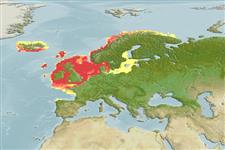Environment: milieu / climate zone / depth range / distribution range
पारिस्थितिकी
समुद्री ड़िमरसल; औशिनोड़िरोमस (Ref. 51243); गहराई सीमा 20 - 150 m (Ref. 9988). Temperate; 72°N - 43°N, 25°W - 45°E (Ref. 54565)
Northeast Atlantic: Bay of Biscay to Iceland and Norway; Barents and White seas; also Baltic Sea.
Length at first maturity / आकार / वज़न / Age
Maturity: Lm 21.5, range 11 - 25 cm
Max length : 40.0 cm SL पुल्लिंग / अलिंग; (Ref. 4705); अधिकतम प्रकाशित वज़न: 1.0 kg (Ref. 35388); अधिकतम सूचित उम्र: 12 वर्षो (Ref. 27407)
Adults live mainly on sandy bottoms, from a few meters to about 100 m. Feed mainly on crustaceans and small fishes. Batch spawner (Ref. 51846). Marketed fresh, dried or salted, smoked and frozen; eaten steamed, fried, broiled, boiled. microwaved and baked (Ref. 9988).
Vinnikov, K.A., R.C. Thomson and T.A. Munroe, 2018. Revised classification of the righteye flounders (Teleostei: Pleuronectidae) based on multilocus phylogeny with complete taxon sampling. Molecular phylogenetics and evolution, 125:147-162. (Ref. 122998)
IUCN Red List Status (Ref. 130435)
Threat to humans
Harmless
Human uses
मात्स्यिकी: व्यापारिक
साधन
Special reports
Download XML
इंटरनेट स्रोत
Estimates based on models
Preferred temperature (Ref.
123201): 6.9 - 11.8, mean 8.9 °C (based on 284 cells).
Phylogenetic diversity index (Ref.
82804): PD
50 = 0.5156 [Uniqueness, from 0.5 = low to 2.0 = high].
Bayesian length-weight: a=0.00776 (0.00688 - 0.00876), b=3.09 (3.05 - 3.13), in cm total length, based on LWR estimates for this species (Ref.
93245).
Trophic level (Ref.
69278): 3.0 ±0.0 se; based on diet studies.
Generation time: 3.9 (3.0 - 4.4) years. Estimated as median ln(3)/K based on 20
growth studies.
लौटाव (Ref.
120179): माध्यम, न्यूनतम जनसंख्या दुगनी होने का समय 1.4 - 4.4 वर्ष। (K=0.3-0.6; tm=2-3; tmax=12; Fec=50,000).
Prior r = 0.72, 95% CL = 0.48 - 1.09, Based on 2 stock assessments.
Fishing Vulnerability (Ref.
59153): Moderate vulnerability (40 of 100).
Climate Vulnerability (Ref.
125649): Moderate vulnerability (43 of 100).
Nutrients (Ref.
124155): Calcium = 17.8 [7.9, 75.9] mg/100g; Iron = 0.294 [0.148, 0.565] mg/100g; Protein = 15.7 [13.4, 18.4] %; Omega3 = 0.319 [0.152, 0.656] g/100g; Selenium = 9.9 [3.4, 35.3] μg/100g; VitaminA = 7.93 [1.59, 40.88] μg/100g; Zinc = 0.339 [0.178, 0.808] mg/100g (wet weight);
